
A school of fish in a body of water by Francesco Ungaro-Pexels
15 Interesting Facts about Fish
It’s exciting to explore the underwater world of fish. These organisms are incredibly diverse, ranging in size from tiny guppies to enormous whale sharks. Most of the time, people only pay attention to fish when it’s on the menu. Nevertheless, these creatures are more than simply lovely ornaments for aquariums or things to put on a plate for you to consume. Fish have more species diversity than any other group of vertebrates, with over 32,000 documented species. These are genuinely incredible, intriguing, and fascinating creatures that live in the depths of water bodies all over the world.
Whether they are cooked or hooked, fish have long been an essential part of human existence. They can be kept as pets and are seen to be lucky charms because they come in a variety of sizes, colors, and shapes. Let’s look at some of the most fascinating details regarding fish, such as their physiology and behavior. Read on to find out more about these magnificent creatures, whether you’re a fish enthusiast or just interested in them.
1. The earliest fish were rudimentary jawless animals

Evolution of jawless fish-by Epipelagic-Wikimedia Commons
The Cambrian period saw the emergence of the first soft-bodied chordates, which are the earliest animals that can be categorized as fish. They had notochords, which allowed them to be more nimble than their invertebrate counterparts despite the fact that they lacked a real spine. Throughout the Paleozoic era, fish would keep evolving and branching into a vast range of forms. Throughout the Paleozoic, many fish evolved exterior defenses against predators. The first fish with a jaw emerged during the Silurian epoch, and many of them including sharks became ferocious marine predators rather than just arthropods’ prey.
2. Several aquatic creatures that are often called “fish” are not actually fish
Shellfish, cuttlefish, starfish, crayfish, and jellyfish are a few examples of aquatic creatures that are frequently referred to as “fish” but are not actually fish. Even biologists did not differentiate in the past. A wide variety of aquatic invertebrates, as well as seals, whales, amphibians, crocodiles, and even hippopotamuses, were also categorized as fish by natural historians in the sixteenth century. All mammals, including cetaceans like whales and dolphins, are not fish. The genuine fish are sometimes referred to as finfish (or fin fish) to distinguish them from these other creatures, particularly in aquaculture.
3. Certain fishes have warm-blooded characteristics

Shark underwater in the ocean by PIRO4D-pixabay
Such warm-blooded adaptations can be seen in shark species, tuna, and swordfish, which can dramatically raise their body temperatures above the surrounding water’s temperature.
Read also; 15 Fascinating Facts about Sharks
4. Sailfish is the world’s fastest fish
The fastest fish in the world, according to many, is the sailfish. The fish have been recorded swimming at speeds of more than 68 mph, (110 kph) according to the Australian Museum. According to scientists, it can leap out of the water at a speed of 68 miles per hour quicker than a cheetah can run. The sailfish’s form is undoubtedly the key to its speed. The Sailfish has a huge dorsal fin that runs the entire length of its 6-foot-long body, making it hydrodynamic just the way a plane is aerodynamic.
5. There are more than 32,000 different species of fish

Fish-collage-1502406-by Maklay62-Wikimedia Commons
More than half of the species of vertebrates belong to different fish groups. Around 28,000 known extant species were recognized as of 2006, with nearly 27,000 being bony fish, 970 sharks, rays, and chimeras, and roughly 108 hagfish and lampreys. The nine largest families are Cyprinidae, Gobiidae, Cichlidae, Characidae, Loricariidae, Balitoridae, Serranidae, Labridae, and Scorpaenidae; a third of these species belong to these families.
There are about 64 families that are monotypic, meaning that each includes only one species. There may end up being more than 32,500 species still in existence. New species are found and formally described each year. As of 2016, there were more than 32,000 known species of bony fish and more than 1,100 known species of cartilaginous fish. Species are exterminated by natural causes. The Chinese paddlefish and smooth handfish are recent examples.
Read also; 20 Best Facts about Dolphins
6. Certain fish species can survive in both freshwater and saltwater
The variety of fish species is nearly comparable between freshwater and marine (oceanic) habitats. Marine fish diversity is concentrated in the Indo-Pacific on coral reefs, while continental freshwater fish diversity is highest in vast river basins of tropical rainforests, particularly the Amazon, Congo, and Mekong basins. Neotropical freshwaters alone are home to more than 5,600 different species of fish, making up nearly 10% of all vertebrate species on Earth. Fish that can survive a wide range of salinity at some point in their life cycle are referred to be euryhaline species. These fish, which include salmon, eels, red drum, striped bass, and flounder, may live or survive in a wide variety of salinities, from fresh to brackish to marine waters.
7. Fish are the world’s first true vertebrates

Agnatha – Drepanaspis gemuendensis-by Ryan Somma-Wikimedia Commons
Fish began to evolve around 530 million years ago, during the Cambrian explosion. This is when the earliest chordates, which later gave rise to the first craniates and vertebrates, began to build the skull and spinal column. The Agnatha, or jawless fish, are the ancestors of all other fish species. Haikouichthys is among the earliest instances. Conodonts, which resembled jawless eels, and ostracoderm, tiny fish with largely armored bodies, made their initial appearances in the late Cambrian. The majority of jawless fish are now extinct, although modern lampreys resemble prehistoric jawless fish. Lampreys are members of the Cyclostomata, a clade that also contains living hogfish and may have diverged from other agnathans in the distant past.
8. Fish have typically tiny brains
Compared to other vertebrates, fish typically have relatively small brains, about one-fifth the size of a comparable-sized bird or mammal’s brain. Sharks and mormyrids, which have brains that are roughly as enormous in relation to body weight as those of birds and marsupials, are two fish species that have comparatively large brains.
9. Many fish species, including clownfish, have the ability to change their sex

Common clownfish 3626111 by Andreas L-Pexels
The initial reproductive organs of a fish wither away as they get older or as their mate passes away, and new reproductive organs develop, causing the fish to change sex. Several fish species, such as gobies, moray eels, wrasses, and clownfish, are known to change their sex and alter their reproductive capabilities. There is always a female fish at the top of the hierarchy in a school of clownfish. The most dominating male switches sexes when she passes away, and he replaces her.
10. Certain types of fish can breathe air
Fish that are amphibious, like the mudskipper, may live and move around in water that is stagnant or otherwise depleted of oxygen for up to many days. These fish can breathe air via a number of different techniques. Anguillid eels’ skin has the potential to directly absorb oxygen. The electric eel may breathe air through its buccal cavity. The digestive tracts of catfish belonging to the families Loricariidae, Callichthyidae, and Scoloplacidae allow them to breathe.
With the exception of the Australian lungfish, lungfish, and bichirs must surface in order to breathe in fresh air through the mouth and expel used air through the gills. The vascularized swim bladder of the gar and the bowfin performs the same function. Several catfish, including loaches and trahiras, breathe by passing air through their guts. Mudskippers absorb oxygen through their skin (similar to frogs) in order to breathe.
11. The majority of fish have highly developed senses

Goldfish in water by imsogabriel Stock-Pexels
Almost all fish in the daytime have color vision that is at least as good as that of a person. Chemoreceptors, which are the source of remarkable perceptions of taste and smell, are also present in many fish. Although having ears, many fish may not have particularly good hearing. The lateral line system, which is composed of sensitive receptors in the majority of fish, can sense the movement of adjacent fish and prey as well as subtle currents and vibrations.
12. Not all fish produce eggs
Fish reproduce in a variety of ways, but the majority lay a large number of tiny eggs that are fertilized and dispersed outside the body. Nonetheless, live-bearing fish, including guppies, platies, mollies, and swordtails, are some of the most well-known tropical aquarium species ever. They are so named because, unlike other freshwater fish species, their mothers give birth to live young. Also, fish species including surfperches, and some sharks are capable of bearing and giving birth to live offspring.
13. Whale sharks are the world’s biggest fish

Whale shark by Red Brick-Pexels
The sole reason the whale shark (Rhincodon typus) is given the moniker “whale” is due to its size. The whale shark, which can grow to a length of more than 40 feet, is the largest species of fish, just as the blue whale (Balaenoptera musculus) is the largest living animal. Whale sharks have developed into the largest fish in the world as a result of consuming enormous quantities of microscopic prey in the frigid ocean depths.
14. Fish are a valuable resource for people all around the world
Economically speaking, humans have long used fish as a source of nutritive protein in their diet. In many nations, fish farming, which has been practiced in ancient China since around 3,500 BCE, is growing in importance. Fish have been prized as a source of beauty for recreational purposes for almost as long as they have been used as sustenance. They appear in cave art, are raised as decorative fish in ponds, and are displayed in aquariums in homes, businesses, and public spaces. Through the millennia, fish have played a significant role in culture, acting as deities, religious symbols, and the topic of artwork, books, and films.
Read also; Top 10 Interesting Facts about S.E.A. Aquarium
15. Fish have color variations

Blue and black fish by Pixabay-Pexels
According to their demands for camouflage, the season, and the habitat, fish are also known to alter their color. Most fish have darker upper body regions, a phenomenon is known as countershading. The lower down you go, the lighter their color gets. This, according to scientists, aids fish in defending themselves from predators hovering above them. It’s harder to spot the fish from above due to their countershading.
Planning a trip to Paris ? Get ready !
These are Amazon’s best-selling travel products that you may need for coming to Paris.
Bookstore
- The best travel book : Rick Steves – Paris 2023 – Learn more here
- Fodor’s Paris 2024 – Learn more here
Travel Gear
- Venture Pal Lightweight Backpack – Learn more here
- Samsonite Winfield 2 28″ Luggage – Learn more here
- Swig Savvy’s Stainless Steel Insulated Water Bottle – Learn more here
Check Amazon’s best-seller list for the most popular travel accessories. We sometimes read this list just to find out what new travel products people are buying.









